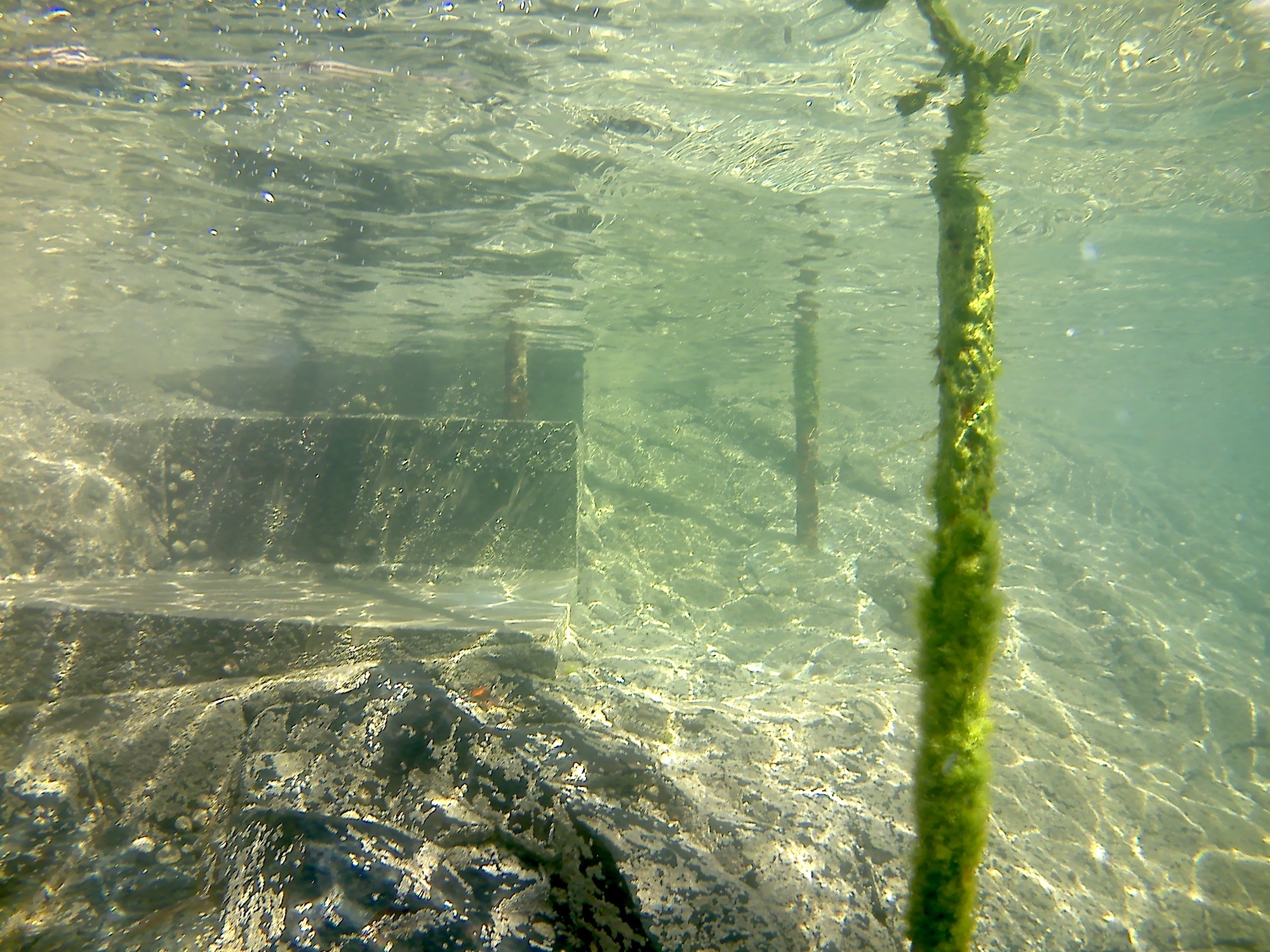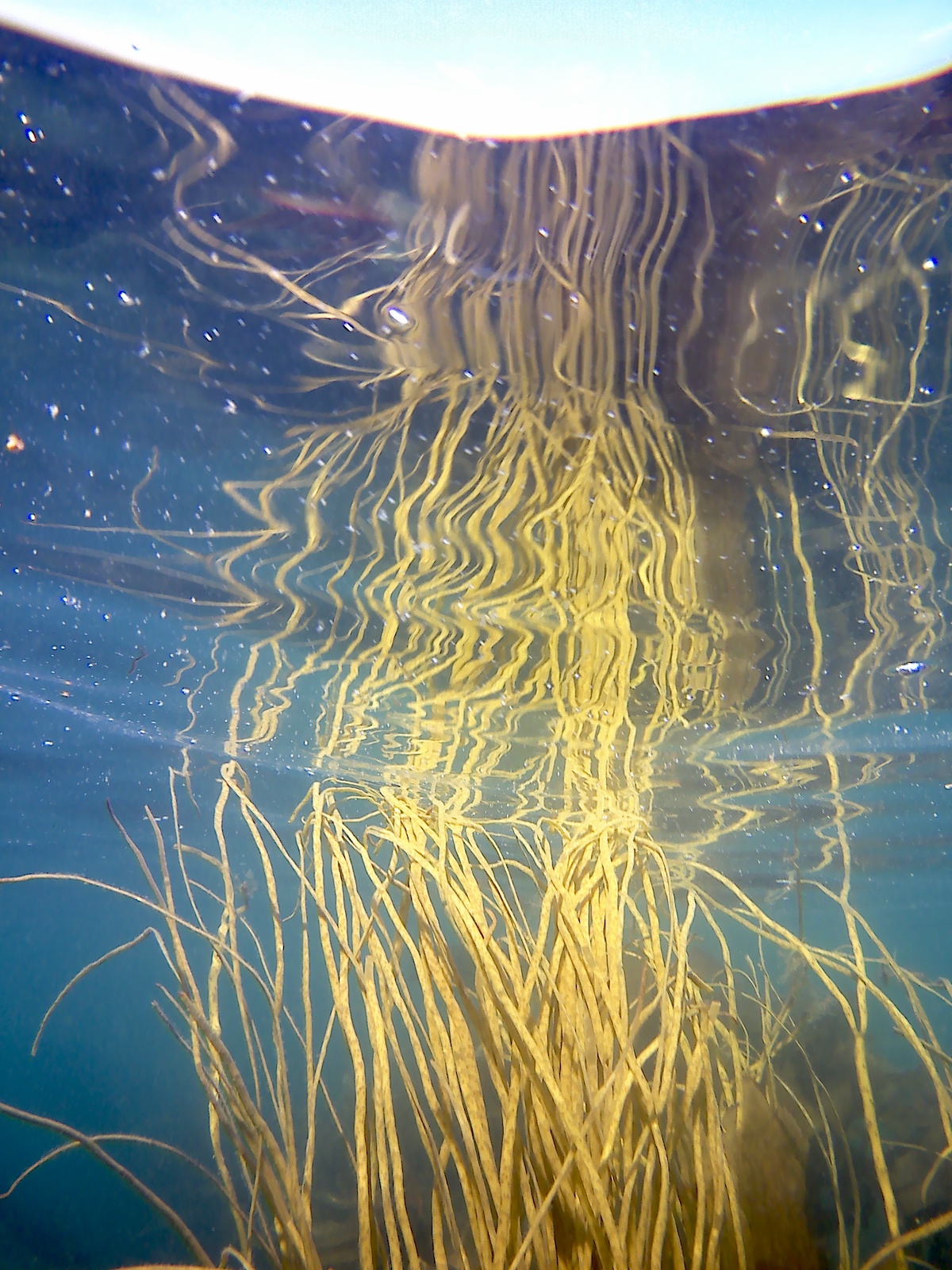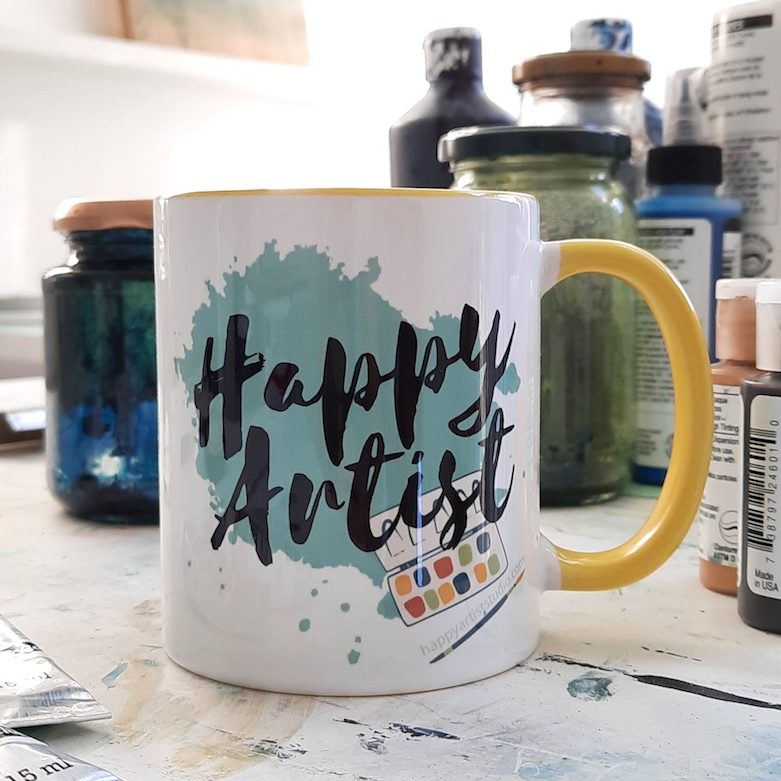
Swimming lessons for artists. I’m thinking that might be my best title ever, although Google probably won’t like it. Too clever and ambiguous. You know me; too clever and ambiguous by half.
Anywho.
If you follow me on Instagram you may have seen some of my ‘swimming stories‘, or sea stories, as some people are calling them, {love that!}, recently.
Perhaps inevitably, I’ve been drawing some interesting parallels between navigating my fears around sea swimming and the all too common struggles and fears around making art.
Turns out sea swimming is absolutely riddled with useful and beautiful guidance for us as artists.
Let’s dive in!
{#sorrynotsorry}
Lesson 1: Don’t let supplies be the reason you don’t start

Photo of me in my very attractive {but not very effective} snorkel by the lovely Philippa Stanton
What the sea taught me:
Start with what you have, and it’ll soon become clear what you want {and need} to invest in.
When I started swimming down by the rocks with the {long established} group of people who swim there year round, I felt a bit intimidated by my lack of knowledge around what I might need, and what might make me look like an embarrassingly over-enthusiastic newbie.
I did buy a Dry Robe – handy for getting changed in relative warmth and with a modicum of decency, although it turns out I barely use it while the weather’s good. {Decency be damned, apparently.}
But apart from that I used the goggles, the two swimsuits, the old towels, the dorky bootees, and the swimming cap I already had, and you know what? That was fine.
Ok my swimsuits are little more revealing than is entirely necessary for cold water swimming, and the goggles turned out to be useless. And I’ve since invested in a snorkel {and then a better snorkel. And better goggles}.
But no one cares what I use or what I look like. {Of course they don’t, but fears don’t care about logic.}
And more importantly, what I had on day one was just fine for day one. And now, a month and a bit in, I know what I need, what I really don’t need, and what I’d like to invest in.
So I can make my spending choices wisely, based on my actual personal and unique experience.
As in the sea, so in the studio:
Start with what you have, and let that tell you what you need.
Lesson 2: Resistance is part of the deal

What the sea taught me:
There is almost always some form of resistance. AKA, conditions will never be perfect.
This is good intel, because it means that
- a} resistance is mostly habitual thought patterns and has nothing to do with the thing itself, and
- b} if you’ll never fully get rid of it, you might as well just carry on.
When I’m walking along the prom and it’s raining, or windy, or both, or there’s a chill in the air that wasn’t there yesterday, or the tide’s looking crazily low and seaweedy, my brain is very busy.
It’s telling me all about how this is insanity, I’ll never keep it up all through the winter, and this is likely to be the day that it’s a miserable experience because all the essential factors are not in place.
{And even if they are, it’ll think up some new ones.}
Here’s what I do. I use three words and one word. The three words are ‘I don’t know’, and ‘just’.
- When I park the car, I tell myself I don’t know what the sea’s actually doing, so I’ll just walk to the end of the road where the prom is, and see how things look from there.
- Once on the prom, I tell myself I don’t know what it’s like down at the rocks and can’t possibly make an informed decision from here, so I’ll just start walking towards the rocks and see how that goes.
- At the rocks, I tell myself I don’t know if anyone’s here today, so I’ll just go down the side and see who’s about. {If no one, I’ll wait. It’s never no one.}
Then I see the others, I see the water, I remember what it feels like to be in the water, and the high afterwards, and I think, well I’m here now, might as well get in.
And I always get in, and I never regret it. {So far anyway! I’ll be testing this lesson hard come October!}
As in the sea, so in the studio:
Get in there and get started by increments.
- Make a coffee/other delicious beverage and decide that you don’t know what might be on the cards today, so you’ll just take it into the studio.
- Once you’re in, consider that you don’t know whether you’ll actually get anything done at all, but you’ll just move a few things around, tidy up a bit, and see what happens.
- You’ll probably have some sort of idea at this point, and then it’s a case of, well you don’t know if it’ll work, but since you’ve got the materials out you’ll just give it a quick go, and take it from there.
Keep ‘just’ doing whatever next tiny thing comes to you, and before you know it you’ll be swimming making art.
Lesson 3: There’s always a way in

What the sea taught me:
There’s never just one way to begin. {Except to begin, obviously. But there are infinite hows.}
An extension of lesson 2, this works because as artists we need variation.
There are several ways to get in the water from the rocks; two sets of steps, two platforms, and other jumping or climbing possibilities, depending on what the tide’s doing and how rough the water is.
If one isn’t an option, another will be.
And if it’s altogether too wild at the rocks, there’s the harbour; and failing that, the Jubilee Pool {the outdoor saltwater pool next to the rocks}.
As in the sea, so in the studio:
There’s always a way in, it’s just a case of persevering till you find it.
If the way you were making art yesterday does not feel so good to you today – perhaps you were flinging paint about with your whole body, and today your energy levels are much lower – find another way in.
Utilise lesson 2 if necessary, and once you’re in there, look for alternative doorways to get you in to making.
Lesson 4: Look closer to dissolve the fears

What the sea taught me:
The things I fear are often beautiful. It is only their ‘unknownness’ that triggers the horror stories. When they are no longer unknown, they are no longer {as} frightening.
I have a mortal fear of seaweed. Correction: I had a mortal fear of seaweed. Now I have a mild one.
I’m not alone in this; judging by the responses to my stories most of us have this fear, whether it’s to do with what’s lurking amongst it, fear of being grabbed and pulled down into the abyss, or, as in my case, being touched by something I can’t see.
It’s why I wear the ridiculous bootees, in part. Minimise the touching! Depending on what the tide’s doing, the seaweed can be Right There beneath me, or safely far below.
It truly was only by getting in there with the scary seaweed, taking my snorkel and camera and precautionary footwear, and realising that what lies beneath is the most abundant, beautiful, diverse underwater garden, that I was able to let go of the vice-like grip of the fear.
Not gonna lie; I still don’t love being wrapped in strands of underwater spaghetti, or accidentally brushing the thick rubbery fronds of the kelp when I’m treading water.
But I’ve swum through the seaweed when the surface is only a couple of feet above it, I’ve waded through it {waded!} to touch a huge {non-stinging} jellyfish {with courage borrowed from a knowledgeable swimming friend right next to me}, and I’ve clambered through it to stand on top of the rock I doubted I’d ever reach.
I’m not a superhero {although I ‘may’ have felt like one a couple of times there}, or even unusually brave.
I’m just someone who really really wants the bounty – to get to see and be part of all that wild beauty, a sense of achievement, wild endorphins, {endolphins, as Roger Deakin so brilliantly called them}, and some of the most inspiring and exciting reference photos I’ve ever taken for my art.
As in the sea, so in the studio:
Sorry to be the bearer of ‘bad’ news, but if there’s something you want – sales, mastery, the courage to share, gallery representation, just to be able to paint what you want without being massacred by inner demons – there is no other way but through.
Find support {a knowledgeable, encouraging friend, mentor, or teacher}, think of the rewards, and get a little closer to the thing you’re afraid of.
Worth it – and works – every time.
Lesson 5: Everything has a price.

What the sea taught me:
There’s a cost to saying yes and a cost to saying no. Which is the higher cost?
Might sound harsh but it has a way of cutting through the crap.
One morning, I just didn’t go swimming. I didn’t even have a good reason. And oh, it came at a price.
The price was a foul mood, a smidgeon of road rage, extremely uncomfortable antsiness – an actual physical fizzing inside my body – and a big old rant at someone I love who took it like a champ but did nothing to deserve it.
Oh, and massive FOMO. {Or rather, KIMO. Knowing I’d Missed Out.}
Not ideal.
The cost of me not swimming {except on days I actively choose not to, see Lesson 6}, is much higher than the cost that is the extra bit of effort required to plough through resistance, violent weather, and fear of what lies beneath.
As in the sea, so in the studio:
What’s the cost of you not getting to make your art? Is it worth it?
Lesson 6: You always have a choice.

What the sea taught me:
Choosing not to do the thing is a choice you can make. No judgements on that.
And when circumstances choose for you, you can actively choose that too.
When I didn’t go swimming that day and turned into a ranting monster, I didn’t make the choice with any kind of conscious, considered energy.
Two days ago, despite getting as far as the slipway down to the rocks, I again didn’t swim, and it was a considered, conscious choice.
I stood there for several minutes, leafing through my thoughts and feelings until I was clear on what I wanted and what cost I was prepared to pay that day. And then I went home.
I felt fine about it; good ,even. It was the right choice even though I didn’t swim, and I didn’t regret it and no one got ranted at. It was a cleanly made decision.
As in the sea, so in the studio:
You can choose not to answer the call. There is power in consciously saying to yourself, today I’m going to do something else.
{Even if that’s because you have to. Our power lies in our decision to choose what’s happening.}
~~~
As we near the 2000 word count {?!}, I’m going to stop there with the swimming lessons for artists for today! Even though there are probably endless lessons in doing anything that challenges you.
None of this will be new to you, but my hope is that the ideas offer reassuring reminders, or fresh ways to see what are very common experiences to artists and swimmers {and humans} alike.
Which swimming lesson will you try today?
🙂







Tara, being a water baby, an ocean swimmer (i grew up a mile from the beach), an artist AND a human this thoroughly resonated. What beautiful lessons the sea holds, if we let it
Yes! And of course more keep coming since I wrote the post. 😉
Enjoyed the lessons. Thanks. I am sure they will come to mind when barriers present themselves.
Brenda
Glad you enjoyed it Brenda!
Tara, this is an excellent and enlightening post. Thanks so much for your advice!!
Thank you very much Mary – so glad you enjoyed it! 🙂
Lovely to have your ‘take’ about insecurities on the art front. It’s good to know that I am not the only one, so thanks for sharing your feelings/ thoughts .
If there’s one thing I’ve learned, it’s that it’s never ‘just you’! But it definitely helps to have actual evidence of that too! Glad this was helpful to you Mary.
Thanks for sharing this.. It made me cry.. The good kinda tears tho ; ) I really loved your “I don’t know” and “I’ll just” idea. I will defiantly use that..
My brain is constantly trying to thwart me with imagined scenarios and elaborate stories as to why “I can’t” or “I shouldn’t” do whatever it is I had planned or wanted to do. Then I find myself just walking in circles, repeating “I don’t know, I don’t know” over and over!
I needed something to say back.. like “I’ll just” to stop the monsters from keeping me stuck, immobile and unable to do anything. Thank you.
Aw! So glad you found something useful in the post Jenn. Those voices can be paralysing, and it’s always helpful to have a few counter points up your sleeve! Happy to have been able to offer what works for me, and hope it helps!
Oh Jenn, I was composing a note to Tara but you have said EXACTLY what I wanted to say. I took some photos on my beach walk today, in preparation for a painting around ‘Here comes the sun’ which holds deep significance for me. I’ve got as far as printing them out and have since done anything but get out any art materials. ‘I don’t know ‘ and ‘I’ll just’ is going to be my mantra from now on.
Thank you Tara 🙂
Love that you found something you can use here Gill – hope it helped you get moving again!
I am inspired by your art and your comments. Thank you so much.
Thank you Becca! Glad you enjoyed it. 🙂
This is brilliant advice for life (I’m creative but wouldn’t call myself an artist).
I’m going to be writing some of this out to go on my fridge to remind me (to go with my “you’re doing really well” card!).
Thank you for sharing your wise, and so helpful, words, Tara.
Most welcome!